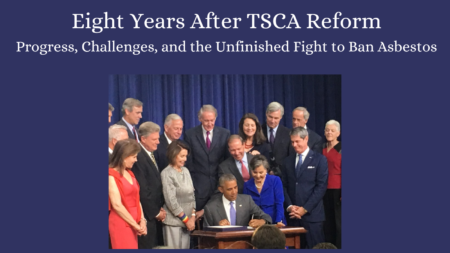April 22, 2024 Release: ADAO FILES PETITION IN DC CIRCUIT COURT TO STRENGTHEN EPA’S PART 1 CHRYSOTILE ASBESTOS RULE, ADVOCATING FOR COMPREHENSIVE PUBLIC HEALTH PROTECTIONS
May 20, 2024 Release: ADAO FILES MOTION TO INTERVENE TO OPPOSE EFFORTS TO WEAKEN EPA PART 1 CHRYSOTILE ASBESTOS RULE
Posted on May 30, 2024
As we mark the eighth anniversary of The Frank R. Lautenberg Chemical Safety for the 21st Century Act (LCSA) on June 22, it’s crucial to reflect on the significant strides we’ve made, the challenges we’ve faced, and the work that still lies ahead in the fight against asbestos.
During the White House signing ceremony, President Obama explained why the new law was needed:
“…the system was so complex, so burdensome that our country hasn’t even been able to uphold a ban on asbestos – a known carcinogen that kills as many as 10,000 Americans every year. I think a lot of Americans would be shocked by that.”
President Obama’s words underscored the urgent need for this type of legislation. However since LCSA was passed, the journey to implement the LCSA has been marked by both victories and ongoing battles.
The Wins
One of the most notable achievements that took place under the LCSA’s enactment was the prioritization of asbestos for risk evaluation and management by the Environmental Protection Agency (EPA). This prioritization was a direct response to the longstanding failure to ban asbestos despite its known carcinogenic properties and the fact that it claims nearly 40,000 American lives annually.
PART 1: CHRYSOTILE ASBESTOS FINAL RULE (MARCH 18, 2024)
In 2024, the EPA took a crucial step towards remedying this failure by releasing the Part 1 Chrysotile Asbestos final rule to ban six conditions of use for chrysotile asbestos. This ban, covering products like asbestos diaphragms and sheet gaskets, was a significant move toward eliminating asbestos exposure in specific industries.
The progress under the LCSA has been driven by relentless advocacy from NGOs and legislative champions, who ensured that the EPA considered the most vulnerable populations and prioritized public health over industrial costs.
The Challenges
Despite these wins, the fight against asbestos is far from over. The EPA’s final rule, announced on March 18, 2024, only addresses chrysotile asbestos and a limited number of conditions of use. The transition for industry will take as much as 12 years.
The chlor-alkali industry remains a primary importer and user of asbestos, relying on outdated diaphragm technology. Although only a few plants continue to use asbestos, the impact of these plants can be felt by the vulnerable communities who live, work, and play in and around them. Further, most of the industry has long since transitioned to safer, non-asbestos alternatives. This underscores the fact that the industry can and should away from using deadly asbestos fibers.
Legal Actions
In addition to these challenges, the American Chemistry Council and three state affiliates swiftly filed a Petition for Review against the EPA’s Part 1 Chrysotile Asbestos Final Rule. The unfortunate reality is that a multidistrict consolidation lottery has placed these cases in the same circuit that overturned an asbestos ban in 1989.
In response to the industry’s lawsuit, ADAO, supported by physicians, organizations, and associations, filed a Petition for Review to refute industry’s claims, defend the science EPA used in the Part 1 rule, and work to strengthen the rule for public health. Read more in the Motion to Intervene filed by Bob Sussman, ADAO’s counsel.
PART 2 DRAFT RISK EVALUATION REVIEW: ADDRESSING LEGACY ASBESTOS (APRIL 16, 2024)
Meanwhile, the EPA is also conducting a Part 2 review, focusing on legacy asbestos in homes, schools, workplaces, and after natural disasters. Legacy asbestos continues to pose significant health risks, and ADAO is actively involved in advocating for comprehensive risk management measures to protect the public from exposure to these remnants.
As such, ADAO filed detailed comments on the Environmental Protection Agency’s (EPA) Part 2 Draft Asbestos Risk Evaluation. ADAO’s comments seek extensive changes in EPA’s draft evaluation so that it recognizes the full magnitude of the dangers legacy asbestos poses to the public.
Legacy asbestos is an insidious hazard. Despite its known carcinogenic properties and the absence of a safe exposure level, the draft evaluation does not capture the full scope of risk nor the urgency needed to mitigate these dangers.
Moving Forward
Looking forward, the path to a complete ban on asbestos involves both regulatory action and legislative support. The Alan Reinstein Ban Asbestos Now (ARBAN) Act represents a critical piece of this puzzle. This comprehensive legislation would prohibit all forms of asbestos and all conditions of use, thereby eliminating any loopholes that current regulations leave open.
As we reflect on the progress made since the LCSA was signed into law, we must acknowledge the tireless work of advocates, lawmakers, and public health professionals. Their efforts have laid the groundwork for a future free from asbestos-related diseases. However, the fight is not over. Continued advocacy, public awareness, and legislative action are needed to ensure that the promise of the LCSA is fully realized, and asbestos is banned once and for all.
This anniversary is not just a time to celebrate our victories but also to renew our commitment to the work ahead. The story of the LCSA and the battle against asbestos is a testament to the power of collective action and the importance of unwavering dedication to public health and safety. Together, we can ensure that future generations are free from the dangers of asbestos.
At this moment, we almost have 150,000 signatures for our petition supporting what we already know: Asbestos is a deadly carcinogen that must be banned with no loopholes or exemptions. Sign on now and become part of the ADAO family!
Linda Reinstein

